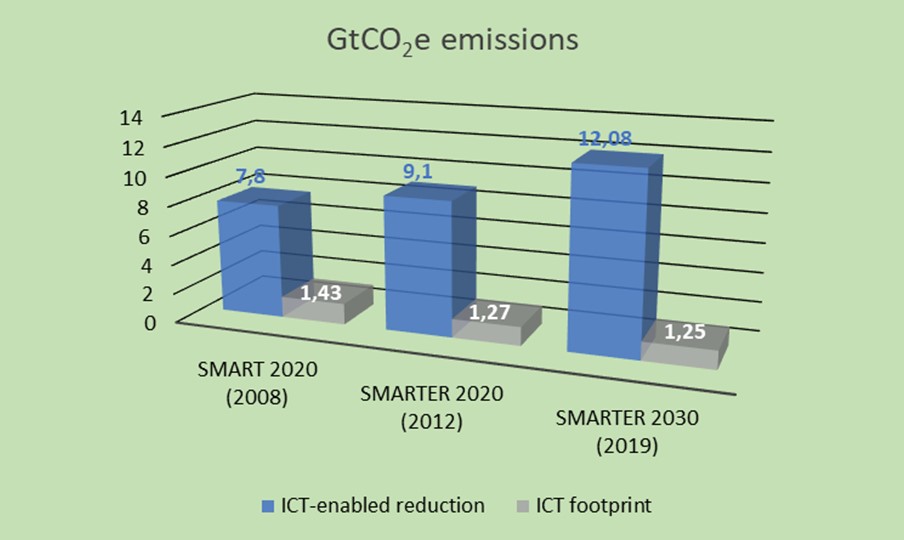Green Communication and Computing for 2030
Introduction
Since the United Nations General Assembly in December 1987, and its Resolution 42/187, sustainable development has become the aspiration of modern societies. Meanwhile, the development of Information and Communication Technologies (ICT), in the 21st century, has contributed remarkably to global energy consumption, although the translation of the data traffic volume to energy use (in particular fossil energy carriers consumption) and greenhouse gas emissions is not straightforward. According to the famous SMART2020 report [1] the ICT carbon footprint (CO2e1 emissions) was supposed to increase from 0.53 Gt CO2e in 2002 to 1.43 Gt by 2020. However, newer reports, i.e. SMARTer2020 [2] and SMARTer2030 [3] corrected these predictions and showed a stabilized trend in the ICT footprint.
ICT carbon footprint
What we can read from the reports mentioned earlier? Importantly, ICT brings eco-opportunities to many other business sectors. Although the ICT sector’s own emissions are expected to stabilize to 1.25 GtCO2e in 2030, specific ICT opportunities identified in [1]-[3] should lead to emission reductions in ICT –enabled sectors seven times the size of the sector’s own footprint by 2020 [2], and more than nine times by 2030 [3] of total emissions! (Have a look at the chart below.) Moreover, analyses in [3] show that ICT has the potential to enable a 20% reduction of global CO2e emissions by 2030, holding them at 2015 levels. On the other hand, the authors of [4] claim that the hopes set on digitalization reducing energy consumption have not yet been justified and that the energy-increasing effects of digitalization so far have been greater than the energy-reducing effects.

Green communication
Reduced-energy wireless communication (a.k.a. green communication) has been an ambition of the Fifth Generation (5G) radio [5]. The so-called zero-energy radios are envisioned for future Sixth Generation (6G) systems as their technology enablers [6]. There are some well-known methods for saving energy in information transmission over radio access- and core networks, as well as in information processing/computing.
Contemporary network services involve both communication and computing (C&C) of information across the network, and thus, key performance indicators including energy-efficiency of communication and computing should be handled jointly. The challenges of future massive, yet energy-efficient C&C require a new architectural and algorithmic approach to the network design. In [7], we discuss the fog network architecture for future IoT services together with some use-cases (computations/tasks offloading, multimedia cashing, vehicle-to-vehicle/infrastructure/anything communication, remote control in robotics and data processing), computational awareness of communication networks, and the opportunities for greening the future C&C.
Summary
Note that all reports and forecasts for 10 years horizon show that the ICT business will continuously grow. However, it will also face challenges from climate change. The expectations are that the ICT sector will not only reduce its own carbon footprint but also deliver significant reductions in CO2e emissions to other business sectors. Over 3 trillion US Dollars is likely to be spent on research and development in the ICT sector up to 2030 [3], indicating huge potential for innovative solutions to the Sustainable Development Goals [3]. Let’s hope for great ideas in green communication area to achieve them!
Note
I would like to encourage readers interested in green communication to have a look at our open-access article published by IEEE Communication Technology News [7].
Resources
Take a look at other posts on our blog related to the current trends and future of radiocommunications:
References
[1] Global e-Sustainability Initiative, The Climate Group, “SMART 2020: Enabling the low carbon economy in the information age”, 2008 https://www.theclimategroup.org/sites/default/files/ archive/files/Smart2020Report.pdf
[2] Global e-Sustainability Initiative, The Boston Consulting Group, “GeSI SMARTer 2020: The Role of ICT in Driving a Sustainable Future”, 2012, https://gesi.org/research/gesi-smarter2020-the-role-of-ict-in-driving-a-sustainable-future
[3] Global e-Sustainability Initiative and Deloitte, “Digital with Purpose: Delivering a SMARTer2030”, 2019, https://gesi.org/research/gesi-digital-with-purpose-full-report
[4] S. Lange, J. Pohl, T. Santarius, “Digitalization and energy consumption. Does ICT reduce energy demand?”, Ecological Economics, Vol. 176, Oct. 2020, 106760
[5] EU 5G Infrastructure Public Private Partnership Association, “5G Vision: the next generation of communication networks and services”, 2015 https://5g-ppp.eu/wp-content/uploads/2015/02/5G-Vision-Brochure-v1.pdf
[6] M. Latva-aho, K. Leppänen (eds.), “Key drivers and research challenges for 6G ubiquitous wireless intelligence”, 6G Research Visions 1, Sept. 2019, ISBN 978-952-62-2353-7
[7] H. Bogucka, F. Idzikowski, B. Bossy, „Energy-Efficiency in Future Massive Communication and Computing Networks”, IEEE Communication Technology News, Aug. 2020, https://www.comsoc.org/publications/ctn/balancing-explosive-growth-dramatic-energy-efficiency-improvements-necessity-green
1 The Equivalent Carbon Dioxide (CO2e) is a term for describing different greenhouse gases in a common unit. For any quantity and type of greenhouse gas, CO2e signifies the amount of CO2 which would have the equivalent global warming impact.
2 Based on the slideshow by Luis Neves, GeSI Chairman, „#SMARTer2030: ICT – Disruptive Technologies for Sustainable and Better Living” at 5th ITU Green Standards Week, Nassau, The Bahamas.
Author Bio
Prof. Hanna Bogucka received her Ph.D. with honors in 1995 and Doctor Habilitus Telecommunications in 2006 from Poznan University of Technology (PUT). Currently, she is a full professor and the Director of the Institute of Radiocommunications at PUT. Moreover, prof. Bogucka is the co-founder, Board Member, and the Head of Cooperation of Rimedo Labs, a spin-off from PUT. Prof. Bogucka is involved in research in the area of wireless communications: radio resource management, cognitive radio, and green communication. She has been involved in multiple European 5th – 7th Framework Programme and Horizon 2020 projects, European COST actions, National Science Centre projects, and industry cooperation. Prof. Bogucka is the author of 200 research papers, 3 handbooks on radio communications and digital signal processing, and 3 scientific monographs on flexible and cognitive radio. Prof. Bogucka has been appointed IEEE Communications Society Director of the EAME Region and elected IEEE Radio Communications Committee Chair for the term of 2015-2016. Currently, she is the IEEE ComSoc Fog/Edge Industry Community Regional Chair in Europe, elected Member at Large of the IEEE ComSoc Board of Governors representing the EMEA region (2023-2025), and a member of the Polish Academy of Sciences.
